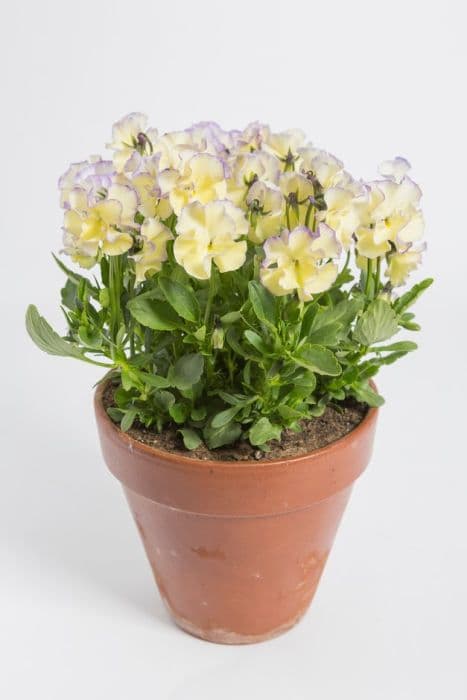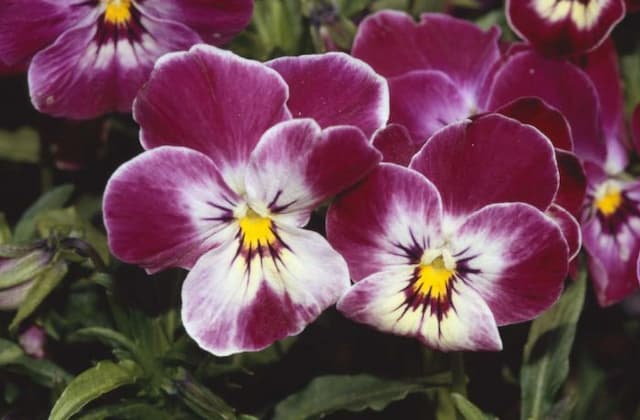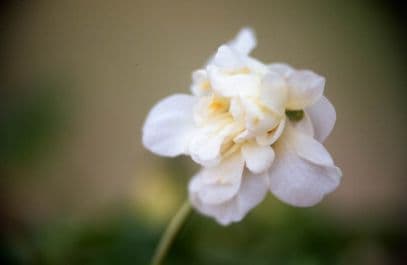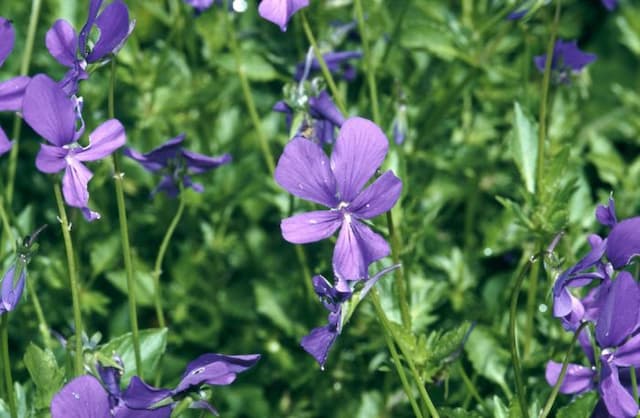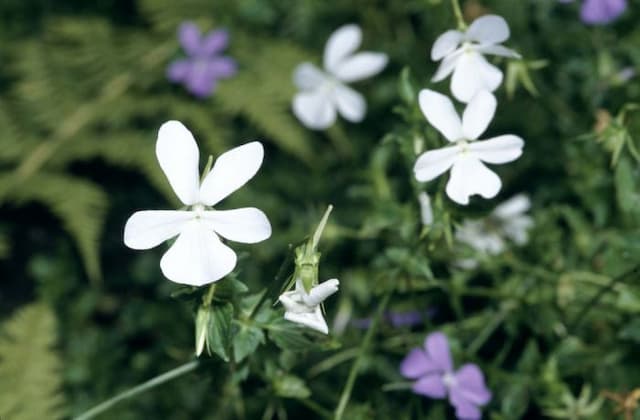Pansy Viola Princess Series

ABOUT
The Viola Princess Series features delightful flowering plants that are recognized for their vibrant and colorful blooms. These plants boast a charming array of flowers that come in a rich palette which often includes purples, blues, yellows, and whites. The blossom's faces typically have a delicate pattern, sometimes showcasing whiskers or intricate lines that radiate from the center. These lines may contrast in color, adding depth and interest to the flower's appearance. The petals of Viola Princess Series plants are rounded, with a slightly overlapping nature that gives the flowers a full and lush look. The lower petal often has a slight indentation, which enhances the overall floral display with its gentle undulations. Each flower holds its own on the plant, creating a delightful sprinkling of color that can be reminiscent of a miniature bouquet. The foliage of these plants is also noteworthy, composed of neat and compact, green leaves. These leaves are typically heart-shaped or rounded with subtle serration around the edges, providing a soft texture to the plant's silhouette. The contrasting green of the leaves serves as a perfect backdrop to highlight the vivid colors of the flowers. The overall appearance of the plant is one of both density and delicacy, creating an appealing aesthetic that is often used for adding splashes of color to gardens, containers, and borders.
About this plant
 Names
NamesFamily
Violaceae
Synonyms
Princess Series Viola, Tufted Pansy
Common names
Viola Princess Series.
 Toxicity
ToxicityTo humans
Pansies, which include the Viola Princess Series, are generally considered non-toxic to humans. They are often used as edible flower garnishes in culinary applications. However, as with any plant, individual allergies or sensitivities could occur, and it's always best to err on the side of caution if you are unsure about personal reactions. In the rare case of an adverse reaction, symptoms could include mild gastrointestinal upset or skin irritation.
To pets
Pansies, encompassing the Viola Princess Series, are also typically safe for pets and are not known to be toxic to dogs or cats. If a pet ingests a large quantity of pansies, it may experience a mild stomach upset, but serious complications are not common. As with any non-food item, pets should not be encouraged to eat ornamental plants as a habit, since it might lead to the ingestion of other, potentially harmful plants or materials.
 Characteristics
CharacteristicsLife cycle
Biennials
Foliage type
Evergreen
Color of leaves
Green
Flower color
Varies
Height
6-10 inches (15-25 cm)
Spread
6-10 inches (15-25 cm)
Plant type
Herb
Hardiness zones
4-9
Native area
Europe
Benefits
 General Benefits
General Benefits- Aesthetic Appeal: Viola Princess Series has a range of vibrant colors that enhance the visual beauty of gardens and landscapes.
- Extended Blooming Season: These plants have a long flowering period, providing color from early spring to fall frost in some climates.
- Low Maintenance: They are generally easy to care for, requiring minimal maintenance beyond regular watering and occasional feeding.
- Cold Tolerance: The Viola Princess Series is known for its ability to withstand cooler temperatures, making it suitable for early spring and late fall planting.
- Versatility: These plants are suitable for various uses, such as in flower beds, container gardens, and as edging plants.
- Attracts Pollinators: The flowers are known to attract butterflies and bees, which are beneficial for the pollination of gardens and ecosystems.
- Edible Flowers: The blooms are edible and can be used to garnish salads, desserts, and drinks, adding a touch of elegance and color.
- Compact Size: Their relatively small size makes them perfect for planting in tight or confined spaces without overcrowding.
 Medical Properties
Medical PropertiesThis plant is not used for medical purposes.
 Air-purifying Qualities
Air-purifying QualitiesThis plant is not specifically known for air purifying qualities.
 Other Uses
Other Uses- Perfume Industry: Pansy extracts can be used in perfumes to provide a subtle floral scent.
- Educational Use: Pansies can be used in schools for teaching botany and plant lifecycle studies due to their distinct seed pod structures.
- Eco-friendly Dyes: The petals of pansies can be used to create natural dyes for fabrics, offering a range of colors from yellow to purple depending on the variety.
- Art Supplies: Children and artists can use pansy petals to create natural pigments for painting or for pressing in art projects.
- Culinary Garnish: Edible varieties of the pansy can be used to add color and a mild flavor to salads, desserts, and cold soups.
- Craft Projects: Pansies can be incorporated into wreaths, potpourris, or dried flower arrangements for home crafts.
- Photography Subjects: With their diverse and vibrant colors, pansies make excellent subjects for macro and botanical photography.
- Cold Climate Gardening: Pansies are cold-tolerant and can be used to add color to gardens in cooler climates where other plants may not thrive.
- Companion Planting: Gardeners can plant pansies near vegetables to attract pollinators, enhancing the pollination of vegetable plants.
- Wedding Decor: Pansies can be used in eco-friendly wedding decor, such as in bouquets, table arrangements, or as part of biodegradable confetti.
Interesting Facts
 Feng Shui
Feng ShuiThe plant Viola is not used in Feng Shui practice.
 Zodiac Sign Compitability
Zodiac Sign CompitabilityThe plant Viola is not used in astrology practice.
 Plant Symbolism
Plant Symbolism- Innocence: The Viola, commonly known as a pansy or violet, often symbolizes innocence due to its delicate and unassuming appearance.
- Remembrance: In the language of flowers, violas are linked with the idea of remembrance, making them a choice for moments when we want to recall someone fondly.
- Love: Various colors of violas can represent different aspects of love. For instance, a purple viola might signify a love that is enduring.
- Free Thinking: Due to its name, which sounds like the word "pensive," pansies are also associated with free thought and consideration.
 Water
WaterPansies should be watered thoroughly once the surface of the soil feels dry to the touch, typically this might be about once a week depending on climate conditions. It's best to water these plants early in the morning to allow the foliage to dry out during the day and to avoid encouraging diseases. When watering, aim for about one gallon of water per square yard of soil, ensuring that the moisture reaches the roots without leaving the soil waterlogged. During hot spells or dry weather, additional watering may be necessary, but always check the soil moisture first. Pansies can suffer from over-watering, so it’s important to ensure good drainage.
 Light
LightPansies thrive best in locations that offer full to partial sunlight. An ideal spot would provide them with at least 6 hours of direct sun daily, but they can also tolerate some shade, especially during the hottest parts of the day. Avoid placing them in deep shade where they might struggle to flourish and produce fewer flowers.
 Temperature
TemperaturePansies prefer cool to moderate temperatures with an ideal range between 40°F and 60°F. They can survive a frost and temperatures down to about 20°F for short periods, but prolonged exposure to heat above 80°F can be detrimental to their health. Therefore, these plants are often enjoyed in spring and fall when the conditions are within their preferred temperature range.
 Pruning
PruningPruning pansies, also known as "deadheading," is essential for encouraging new blooms and preventing the plant from going to seed. Snip off the spent flowers and any dead or yellowing leaves regularly. Pruning is most effective when done weekly throughout the blooming season. The best time to deadhead pansies is in the cool of the evening or early in the morning.
 Cleaning
CleaningAs needed
 Soil
SoilPansies (Viola Princess Series) thrive in moist, well-draining soil with a slightly acidic to neutral pH of 6.0 to 7.0. A good mix for pansies would be equal parts peat, loam, and coarse sand or perlite to ensure proper drainage and aeration. Regular addition of organic matter such as compost will also benefit the plant's growth and flowering.
 Repotting
RepottingPansies typically do not require frequent repotting and can thrive in the same pot for several seasons. However, if you notice stunted growth or the soil degrading, repotting every 1-2 years in fresh soil mix can be beneficial.
 Humidity & Misting
Humidity & MistingPansies (Viola Princess Series) prefer average humidity levels and do not require any special humidity considerations. They can tolerate the natural humidity levels typically found in outdoor garden settings without additional adjustments.
 Suitable locations
Suitable locationsIndoor
Place pansies in bright, indirect light indoors with cool temperature.
Outdoor
Plant pansies in partial shade to full sun and in cool weather.
Hardiness zone
4-8 USDA
 Life cycle
Life cycleThe Viola Princess Series, commonly known as pansies, begin their life as seeds which germinate in cool to moderate temperatures to produce small seedlings with a pair of true leaves after the initial cotyledons. As they grow, these seedlings develop a rosette of leaves close to the soil surface and establish a root system. Following vegetative growth, they enter a flowering stage when daylight hours are sufficient but still relatively cool, producing an array of colorful blooms that can continue to flourish with proper care through varying seasons. After pollination, often aided by insects, the pansies set seed in small capsules that can be harvested once they dry on the plant. The plant may appear to die back, especially in hotter conditions, entering a period of dormancy, but can re-sprout if conditions become favorable again. The seeds can remain viable in the soil for several years, beginning the life cycle anew when conditions are right.
 Propogation
PropogationPropogation time
Spring to Summer
The common method of propagating the Viola Princess Series, commonly known as pansies, is through seed sowing. Seeds are typically sown in late winter or early spring, about 8 to 12 weeks before the last frost date. To propagate pansies from seeds, begin by filling a tray with a moistened seed starting mix. Sprinkle the tiny seeds lightly on the surface and gently press them into the mix, as they need light to germinate. Cover the tray with clear plastic to maintain humidity and place it in a location with bright, indirect sunlight and a temperature of about 65 to 70 degrees Fahrenheit (18 to 21 degrees Celsius). Keep the soil moist, but not waterlogged. Germination should occur in 10 to 14 days. After sprouts appear, remove the plastic cover and continue to keep the soil moist until seedlings are strong enough to be transplanted.
